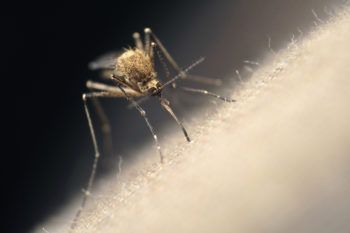Malaria In Texas: What You Need To Know

Last week, the Centers for Disease Control and Prevention issued an advisory concerning several malaria cases detected in the southern United States over the past two months.
The five diagnoses — one in Texas and four in Florida — quickly made headlines, with CDC officials reporting that these are the first cases of malaria to originate inside the U.S. since 2003.
For more on this rare domestic outbreak, Texas A&M Today spoke with Dr. Rebecca Fischer, an infectious disease epidemiologist and assistant professor in the Department of Epidemiology and Biostatistics at the Texas A&M University School of Public Health.
How common is malaria?
Malaria is very common worldwide. It is one of the most common infections on the planet — about half of the world’s population live in places where they are at risk of contracting malaria. However, through one of our nation’s greatest public health successes in history, malaria was eliminated from the U.S. by about 1950. There are still malaria cases in the U.S. every year, but these are contracted in places where malaria normally occurs and then are brought into the U.S. through travel.
What is so significant about these five cases, and what does this discovery mean for U.S. public health?
These five cases in the U.S. are unusual because they seem to have occurred locally. That is, these particular individuals did not travel to areas where malaria is endemic — where it is known to occur naturally. It has been about 20 years since similar cases were detected in the U.S., but while it is unusual, it is not unprecedented.
Infections with the specific species of malaria parasite identified in these cases can take weeks to produce symptoms, sometimes up to a year or more later. The public heath response in these areas has been quick and may have interrupted further spread, but it could be a few more weeks, or longer, before officials know that for sure. For now, the fact that additional cases have not yet been found may indicate containment.
What steps are public health officials taking to respond to this threat, and what precautions can individuals take to stay safe?
Malaria is carried by mosquitoes that, after biting an infected person, can transmit the bloodborne malaria parasite to the next person they bite. Mosquito Control divisions of health departments have a huge responsibility in the southern U.S., where mosquitoes seem to be everywhere you go. It is the responsibility of these specialists to keep mosquitoes at bay — everything from reducing standing water (potential breeding sites for mosquitoes) to removing trash and discarded items from the environment (mosquitoes can breed anywhere there is water, including on leaves and something as small as a bottlecap), and selectively applying pesticides in higher-risk areas.
Mosquitoes are more than annoying, and protection against mosquitoes is important for everyone — not only to avoid malaria. Infections like dengue, Zika, West Nile, and heartworm (for our furry friends) are also carried by mosquitoes. Reducing the ability for mosquitoes to breed is the single most important thing that the public can do to slow the spread of mosquito-borne diseases like malaria. Things like emptying standing water to remove potential breeding habitats is crucial in areas where mosquitoes live.
Personal protection against mosquito bites is also important. If we can decrease mosquito populations and keep them from biting us, our risk of catching any of these diseases will be low.
There is no vaccine for malaria, so prevention is key. If someone does think they have malaria or have been exposed, seeking health care is important in order to get treatment. Infected individuals should isolate away from mosquitoes, indoors, to avoid any mosquito bites. A mosquito that bites an infected person can spread the parasite to others and further the outbreak.
What are some factors that contribute to the emergence and spread of malaria?
The single greatest risk factor for malaria in the U.S. is travel. Anyone visiting or living in a region where malaria is endemic is at risk of contracting the parasite and taking it with them when they travel. According to the CDC, about 2,000 such cases are detected in the U.S. every year. Fortunately, there are effective treatments for malaria. Treatment is important if infected, especially for children and for pregnant women. It is pretty unusual in the U.S. for travel-associated cases to seed outbreaks like what we are experiencing, but it does sometimes happen. Much of the southern U.S. is home to the mosquito that carries the malaria parasite, and mosquito abundance in these areas can be a driver of outbreak risk.
Should residents of Texas and Florida be concerned about contracting malaria?
For now, there is no reason for the average person to be worried about contracting malaria. Given the public health response in the affected areas, it is unlikely that it has become widespread. The fact that additional cases have not been detected yet suggests that the outbreaks may have been contained and brings hope that case counts will be limited.
Media contact: tamunews@tamu.edu





